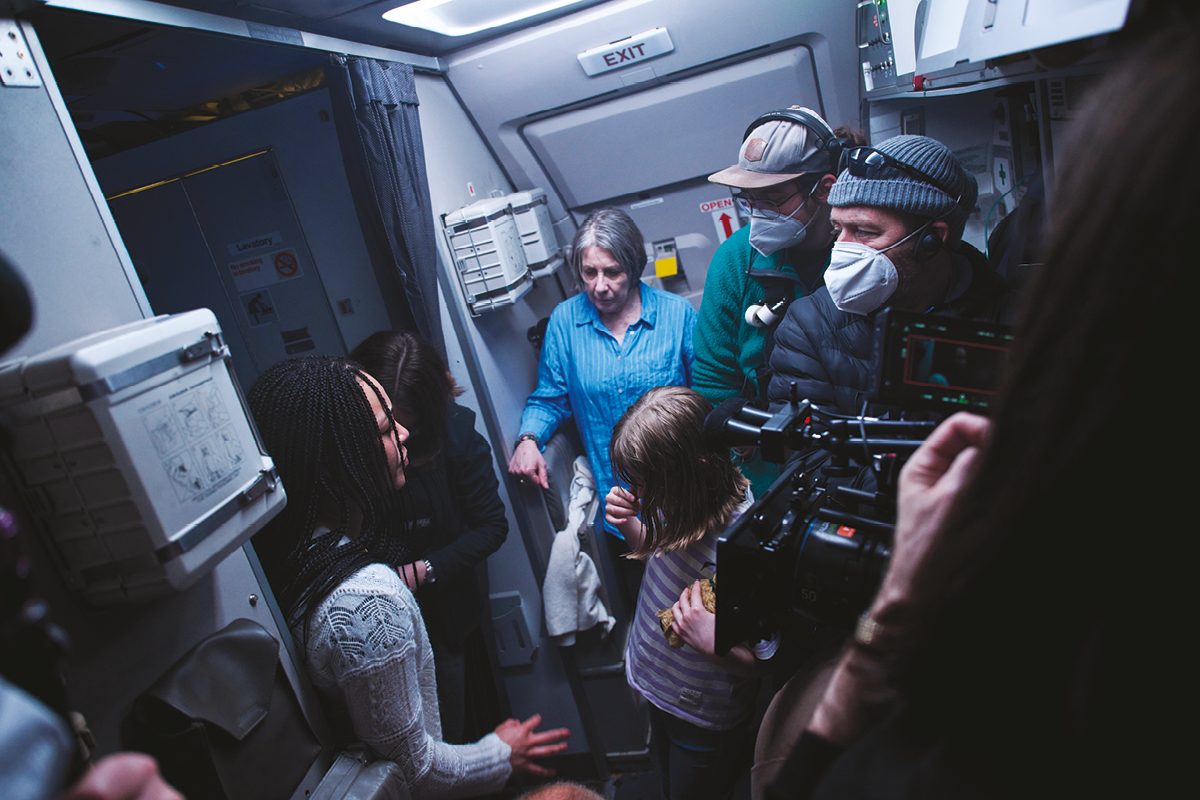
No Way Up
Posted on Apr 13, 2024 by Samara Husbands
Sixty feet under
Survival thriller No Way Up puts a twist on the traditional flight disaster film. Virtual production – handled by Dimension Studio and DNEG – plays an essential role in the gripping final sequence
Words Katie Kasperson Images Kevin Baker
Aplane crashes into shark-infested waters and teeters on the edge of a trench; the passengers must find their way back to the surface before being pulled into the ocean’s abyss.
This is the ambitious, adrenaline-pumping plot of survival film No Way Up, made possible partly by virtual production (VP).
With Claudio Fäh as director and produced by both Annalise Davis and Steve Jelley, also the co-founder/co-CEO of Dimension Studio, No Way Up combines practical filmmaking with VP and VFX in a way that hasn’t quite been done before – or since. The movie was mainly shot inside a model aeroplane, which was then lowered into a water tank. “A plane crashing underwater, plus escape – that’s quite a huge challenge creatively and practically, so it was a massive collaboration,” states Davis.
Coming up for air
Having teamed up with Dimension Studio and DNEG previously, Davis was keen to work with them again on No Way Up – a project employing VP for its final sequence. “There was an ending in No Way Up which required us to shoot our lead actress (Sophie McIntosh) as she swam from the depths to the surface for a long time,” describes Jelley. “That’s something we realised we couldn’t shoot in the tank.”
Due to physical limitations, paired with wanting an uninterrupted performance, Davis and Jelley opted for dry for wet, a filming technique which replicates the look and feel of being underwater.
To do this, they used ROE Visual Black Pearl 2V2 on an LED volume. DOP Andrew Rodger shot the entire film on an ARRI ALEXA LF and Mini LF, with Caldwell Chameleon full-frame anamorphic primes.
“We had an Unreal-based pipeline with a high-resolution plane model,” explains Jelley. “You can quickly get a sense of the lighting and dimensions of the trench, as well as much of the mechanics,” he adds, although the technology has drastically improved since No Way Up was created. “Unreal Engine now has some features we would have liked at the time, such as physically based lighting – rays of light going through the scene.”
According to Davis, the plane crash scene relied on projections instead of LED panels. “If I did that now, I’d put a virtual screen outside the windows, no question,” she admits. “It’s a perfect VP film.
“It was a combination of practical and VFX – probably a lot more practical than you’d think when watching it,” continues Davis. “It’s very well done, but if we did it now, it would be a different conversation.”
Production perks
One of Davis’ responsibilities was to preserve the creative vision. “What’s great about VP is [the heads of each department] can feed into that – they’re part of that process. The actors can see what’s on screen,” she describes. “That’s something powerful about VP; it helps everybody to make things smoother, more collaborative and cohesive.”
Jelley also notes VP’s capability to spark creative continuity, speeding up the schedule and making an actor’s job easier. “A good VP on a controllable sound stage results in fewer interruptions. You’re in a controlled environment where all you need to do is act and perform.”
VP introduces new opportunities – both for story and scope. “People write for the limitations of technology; often, they self-edit,” Jelley describes. “They don’t try to write stuff you can’t shoot. We’re at this interesting juncture now where using a volume opens up crazy possibilities.”
This is especially pertinent for low-budget indie films. “Can we take all of this technology that we know works for Hollywood and put it in service of independent filmmakers who maybe otherwise wouldn’t have a chance to use it?” wonders Jelley.
Do it for the plot
Despite VP’s many advantages, its use requires good reason. “As a producer, you always think about the story first and foremost,” states Davis. “Does it serve the story? If it does, then that’s what you want to do.”
That said, many filmmakers are still sceptical about VP. “Is it going to work? Is it cheaper? Am I going to have to do it all again in visual effects?” Jelley asks. “These are all entirely valid questions to have before committing.”
VP is on track to slowly replace backdrops like blue and green screens, which make it ‘impossible to match the lighting on the subjects’, according to Jelley. “No amount of VFX budget can replicate that. You can do a reasonably good job, but if you can actually capture all of that in-camera, then it’s going to look better,” he argues.
No Way Up is one of a growing band of films which undoubtedly benefits from the rise of VP, pushing the boundaries of what is possible.
This feature was first published in the April 2024 issue of Definition.










